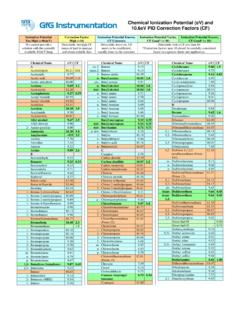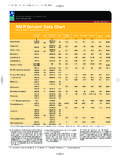Transcription of Classification of Toxic Hazard and Explosive Risk of ...
1 1 / 11 Classification of Toxic Hazard and Explosive Risk of Chemical Mediums in Pressure Vessels (HG 20660-2000) 1. Scope of Application To determine the category and technical requirements for pressure vessels, this Standard classifies the Toxic Hazard and Explosive risk of the mediums. This Standard aims to classify the Toxic Hazard and Explosive risk of the mediums (include raw material, finished products, semi finished articles, tertium quid, reactant, reaction outgrowth and impurity) used or stored in pressure vessels in chemical industry in order to determine the category of pressure vessels and the technical requirements for sealing. 2. Referenced Standards GB 5044-85 Classification of Health Hazard Levels from Occupational Exposure to Toxic Substances The Supervision Regulations on Safety Technology for Pressure Vessels (1990) published by the General Administration of Quality Supervision, Inspection, and Quarantine of P.
2 R. China (hereinafter referred to as the Regulations) 3. Principles for Classification The Toxic Hazard and Explosive risk of chemical mediums defined in this Standard is classified according to the seriousness of the Hazard caused by exposure to the medium and explosion due to accident or the chronic occupational Hazard resulted from regular medium leaking during the operation of the pressure vessels. The Toxic Hazard of chemical mediums is defined based on the six Classification indicators stipulated in GB 5044 (please refer to Annex A Basis for Toxic Hazard Classification ). According to the Hazard of toxicity, chemical mediums are classified as extremely Toxic , highly Toxic and moderate Toxic (Note 1). When determining the category of pressure vessels, the accident situation and the Hazard caused by exposure to the medium should be taken into consideration for the Classification of Toxic Hazard .
3 For this purpose, this Standard makes the Classification after comprehensive study mainly to acute toxicity and the maximum allowable density as well as other parameters. The Tables from to list the common chemical mediums classified as extremely Toxic , highly Toxic and moderate Toxic . 2 / 11 When determining the technical requirements for sealing of pressure vessels in chemical industry, besides the accident situation, the latent chronic Hazard caused by regular leaking shall also be taken into consideration. Therefore, acute toxicity, maximum allowable density and carcinogenicity are the main items for comprehensive consideration to determine the Classification . Some mediums are classified according to its most outstanding Hazard (carcinogenicity for example).
4 The Classification of some mediums listed in Tables from to has been adjusted; please refer to the notes of the Tables for detail. The Classification of Explosive mediums is according to the stipulations of The Supervision Regulations on Safety Technology for Pressure Vessels (Note 2). The Explosive medium means the mixture of steam (produced by gas or liquid) and gas, with the explosion lower limit less than 10%, or the difference between the explosion upper limit and the lower limit higher or equal to 20%. Please refer to Table for detail. When more than one kind of medium are involved, the most hazardous or the medium with the highest risk for explosion shall be used as the criteria to determine its Classification ; when the content of a hazardous medium is very small, its content and Hazard shall be considered comprehensively.
5 According to the Classification principles of this Standard, the design unit or the production department of the user can determine its Classification . The chemical mediums which are not listed in this Standard shall be classified according to the above principles and refer to the Classification of similar mediums. Table Common Chemical Mediums Classified as Extremely Toxic No. Names No. Names 1 Disyston 11 Merhyl parathion 2 Ethyleneimine 12 Parathion 3 Dimethylnitrosamine 13 Phosgene 4 Diborane 14 Methylisocynate 5 Schradan 15 Mercury 3 / 11 6 Triethyl tin chloride 16 Benzo( )pyrene 7 Pentaborane 17 Sulfur mustard 8 Systox 18 Hydrogen cyanide 9 Tetraethyl lead 19 Chloromethyl ether 10 Thimet 20 Nickel carbonyl Note: When the Classification of Toxic Hazard are used to determine the technical requirements for sealing of pressure vessels, Vinyl chloride and Naphthylamine shall be included in this table as extremely Toxic .
6 Note 1: The chemical mediums classified as minor Toxic are not included in this table. Note 2: The Explosive medium referred in this Standard is the inflammable medium defined in the Supervision Regulations on Safety Technology for Pressure Vessels. Table Common Chemical Mediums Classified as Highly Toxic No. English Names No. English Names 1 Dimethylhydrazine 32 Hydrazine 2 Toluene-2,4-diisocyanate 33 Ethylene oxide 3 Oxygen difluoxide 34 Epichlorohydrin 4 Dinitrobenzene (m,o,p) 35 Tsumacide 5 Chloro-dinitrobenzene 36 Ozone 6 1,2-dibromocthane 37 Fenthion 7 1,2-Dibromo-3-chloropropane 38 Dipterex 8 Dichlorotetrafluroproptone 39 DDVP 9 Selenium oxychloride 40 Fluorine 10 Allylcyanide 41 Hydrogen fluoride 11 Sulphurdecafluoxide 42 Arsine 12 Chlorine trifluoride 43 Nicotine 13 2,4,6-Trinitrotoluene 44 Hydrogen selenide 14 Phosphorus trichloride 45 Dimethyl sulfate 15 Phosphorus pentochloride 46 Cyanogen 16 Acrylonitrile 47 Chorine 17 Acrylamine 48 Chlordane 18 Acrolein 49 Chloropicrin 19 Acetone cyanohydrin 50 Cyanogen chloride 20 Demeton methyl 51 -Chloropropionitrile 4 / 11 21 Formaldehyde 52 Chlorinated diphenyls 22 Formic acid 53 Monochloromethanc 23 n-Butyronitrile 54 Chlorinated naphthalenes 24 P-Nitroaniline 55 Chlorophenol 25 P-chloronitrobenzene 56 Trichloromethyl chloroformate 26 Isobutyronitrile 57 Bromomethane 27 Benzylchloride 58 Iodomethane 28 Carbofuran 59 Carbonyl fluoride 29 o-Chloronitrobenzene 60 Phosphine 30 Phenyl acetonitrile 61 Phosphamidon 31 Aniline Note.
7 When the Classification of Toxic Hazard are used to determine the technical requirements for sealing of pressure vessels, Carbontetrachloride, o-Toluidine and Benzene shall be included in this table as highly Toxic chemical mediums. Table Common Chemical Mediums Classified as Moderate Toxic No. English Names No. English Names 1 Monoethanolamine 46 Glycidyl methacrylate 2 Carbon monoxide 47 Methyl mercaptan 3 Chloroacetic acid 48 Methanol 4 Ethylenediamine 49 Butyl mercaptan 5 Diethyloxalate 50 n-Butyraldehyde 6 Ethylidene norbormene 51 n-Methyl silicate 7 Ethylamine 52 Rogor 8 Ethyl mercaptan 53 Etrofolan 9 Acetonitrile 54 Cyclohexanone 10 Ethanoic acid 55 Isobutyraldehyde 11 Acetic anhydride 56 Carbaryl 12 2,6-Dimethylaniline 57 Sumithion 13 Dimethylamine 58 Pyridine 14 Dimethylacetamide 59 o-Toluidine 15 Dimethyldichlorsilane 60 o-Nitrotoluene 16 Dimethylformamide 61 o-Nitrophenol 17 Dimethylaniline 62 Benzene 5 / 11 18 N,N-Dimethylaniline 63 Phenol 19 Sulfurdioxide 64 Benzaldehyde 20 Nitrogenoxide 65 Styrene 21 Carbon disulfide 66 m-Cresol 22 1,1-Dichloroethylene 67 m-Methylaniline 23 1.
8 2-Dichloroethylene 68 Resorcinol 24 1,2-Dichloroethane 69 m-Nitrotoluene 25 Dichloroethane 70 m-Chloroaniline 26 Dichloroethane 71 Fluorobenzene 27 1,3 Dichloropropanol-2 72 Ammonia 28 Buthylamine 73 Vinylidene chloride 29 Crotonaldehyde 74 Naphthalene 30 Sulfur trioxide 75 -Naphthylamine 31 Tribromomethane 76 -Naphthol 32 1,1,2-Trichloroethane 77 Nitrobenzene 33 1,1,2-Trichloroethylene 78 Nitric acid 34 1,2,4-Trichlorobenzene 79 Hydrogen sulfide 35 Trichloroacetic acid 80 Sulfuric acid 36 Trichlorosilane 81 Vinyl chloride 37 Adiponitrile 82 Chloroethanol 38 Malathion 83 Chloroprene 39 Phosphorus pentosulfide 84 3-Chloropropene 40 Tetrabromoethane 85 Hydrogen chloride 41 Tetrachloroethane 86 Chlorobenzene 42 Carbontetrachloride 87 Tri-n-butyl phosphate 43 Allylalcohol 88 Trip-Cresyl phosphate 44 Propyl mercaptan 89 Furfural 45 Methylamine 90 Acetylene Note: When the Classification of Toxic Hazard are used to determine the technical requirements for sealing of pressure vessels, Carbontetrachloride, o-Toluidine and Benzene shall be classified as highly Toxic ; Vinyl chloride and Naphthylamine shall be classified as extremely Toxic .
9 6 / 11 Table Explosive Mediums No. English names No. English names 1 Monomethylamine 147 Propylene 2 Carbon monoxide 148 Allylamine 3 Chlorodlfluorocthane 149 Isopropenylbenzene 4 Ethylene glycol 150 Arcylonitrile 5 Acetylene 151 Ethyl acrylate 6 Ethylamine 152 n-Butylacrylate 7 Ethyl glycol 153 Methyl acrylate 8 Ethyl propylether 154 Propylcarbonate 9 Ethyl propylketone 155 Allyl alcohol 10 5-Ethyl-2-Methylpyridine 156 Acrolein 11 Ethyl cyclobutane 157 Propane 12 Ethyl cyclohexane 158 Propionitrile 13 Ethyl cyclopentane 159 Acetone 14 Ethyl benzene 160 Ethyl propionate 15 Ethylene 161 Methyl propionate 16 Vinylacetylene 162 n-Propyl alcohol 17 Vinylethylether 163 Isopropyl alcohol 18 Vinyltoluene 164 Propyl aldehyde 19 Ethane 165 Petroleum ether 20 Ethyl mercaptan 166 Isoprene 21 Acetonitrile 167 1-Pentylamine 22 Ethyl Dacetoacetate 168 1-Pentene 23 N.
10 N-Dimethylacetamide 169 2-Pentene 24 Acetic acid 170 n-Pentane 25 Vinyl acetate 171 Isopentane 26 Ethyl acetate 172 Methyl propylkctone 27 Butyl acetate 173 3-Pentanone 28 Isobutyl acetate 174 n-Amyl alcohol 7 / 11 29 Sec-butyl acetate 175 3-Pentanol 30 Tert-butyl acetate 176 tert-Amyl alcohol 31 Propyl acetate 177 Isoamyl alcohol primary 32 Isopropyl acetate 178 Isoamyl alcohol secondary 33 Methyl acetate 179 Methyl ethyl ether 34 Amyl acetate 180 Toluene 35 Isopentyl acetate 181 2,4-Tolylene diisocyanate 36 Cyclohexyl acetate 182 Methoxy butylacetate 37 Acetic anhydride 183 o-Cresol 38 Ethyl alcohol 184 m-Cresol 39 Ethoxyglycolacetate 185 p-Cresol 40 Ethyleneimine 186 Methyl glycol 41 Acetaldehyde 187 Methoxyl glycolacetate 42 Etyl ether 188 Methyl vinyl ketone 43 1,1-Diethoxyethane 189 Methyldichlorosilane 44 Diethylamine 190 Methylisobutyketone 45 3,3-Diethylpentane 191 3-Methyl-1-butene 46 p-Diethylbenzene 192 Methyl trichlorosilane 47 N,N-Diethylaniline 193 Ethyl methacrylate 48 Diethyl selenide 194 Methyl methacrylate 49 m-Divinylbenzene 195 2-Methyl acrolein 50 Divinyl ether 196 2-Methyl-2,4-pentanedid 51 n-Dibutylamine 197 2-Methyl pentane 52 Diisobutyl ketone 198 3-Methyl pentane 53 Diacetone alcohol 199 2-Methyl pyridine 54 Diisopeopyl ether 200 3-Methyl pyridine 55 p-Xylene 201 Methyl cyclohexane 56 o-Xylene 202 Methyl cyclopentadiene 57 m-Xylene 203 Methyl cyclopentane 58 Dimethylamine 204 Methyl hydrazine 59 Dimethyldichlorosilane 205 Methane 8 / 11 60 2,2-Dimethylbutane 206 Methyl mercaptan 61 2,3-Dimethylbutane 207 Formic acid 62 2.









